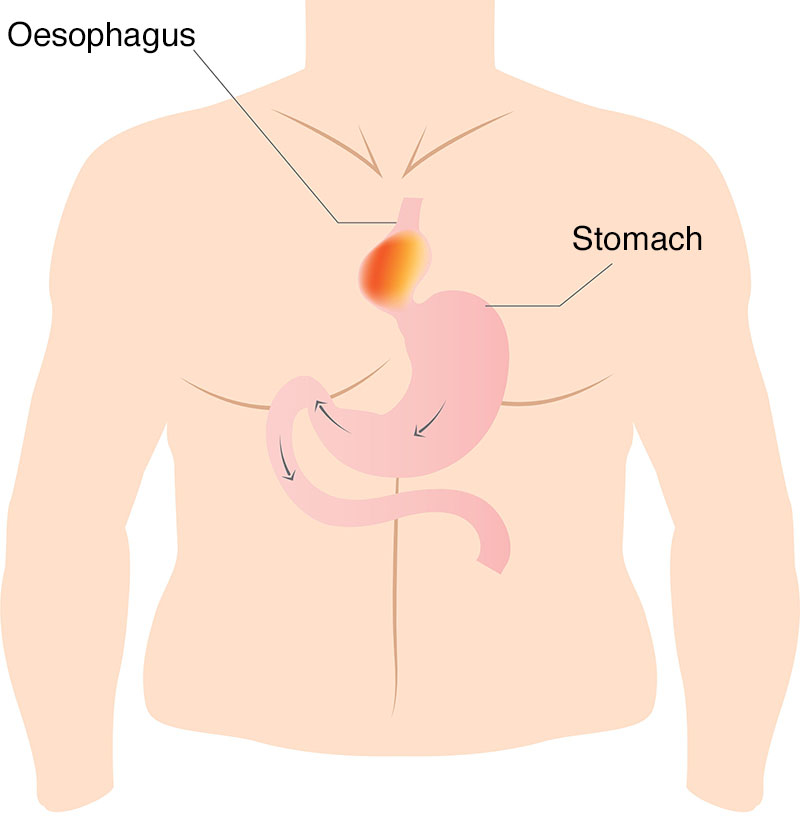What is a hernia?
A hernia occurs when tissues or organs bulge through a weak point in the wall of the belly (abdomen).
There are a number of different types of hernia, including:
- Hiatus hernia — Part of the stomach pushes up into the chest through the opening in the diaphragm (the layer of muscle separating the stomach from the chest) where the oesophagus (food pipe) passes through. It is sometimes called a hiatial hernia.
- Inguinal hernia — The bowel or other abdominal tissue pushes through the abdominal wall in the lower part of the abdomen, causing a lump in the groin. Inguinal hernias are more common in men.
- Umbilical hernia — The bowel or abdominal tissue pushes through the abdominal wall near the belly button (naval). Umbilical hernias are more common in newborns.
- Incisional hernia — The bowel or other abdominal tissue pushes through the abdominal wall where it’s been made weak by surgery or trauma.
- Femoral hernia — The bowel or other abdominal tissue pushes through the abdominal wall near where the leg joins the body. Femoral hernias are more common in women.
- Epigastric hernias — The abdominal fat pushes through the abdominal wall between the belly button and below the rib cage.
What causes a hernia?
Some hernias are there at birth. Some occur after surgery.
Other times, weaknesses develop in the muscles of the abdomen over time and eventually ‘give out’, causing a hernia.
Hernias are generally more common in people whose abdomens are under more pressure than usual. This includes people who do a lot of heavy lifting, who are obese, pregnant, have a chronic cough, constipation, sneezing or diarrhoea, or people who smoke.
What are the symptoms of a hernia?
The symptoms of a hernia depend on the size of the hernia and where it is. Typical symptoms include:
- a bulge or lump in the groin or abdomen
- pain, burning, aching, heaviness or discomfort, especially when coughing, straining or lifting
- a pulling sensation around the lump or bulge
Some people may experience shooting hernia pain, vomiting, and constipation. Some hernias may not cause any symptoms at all.
If you have a hiatus hernia in your stomach, you may also experience:
- heartburn
- reflux
- pain in the chest or stomach
- difficulty swallowing, or bringing food or drink back up into your mouth
If you have an inguinal hernia in your groin, you may also experience:
- weakness or pressure in your groin
- swelling and pain around the testicles
In babies and children, an inguinal hernia is usually painless, soft and smooth. It may disappear or get smaller when the child is lying flat, and larger and more noticeable when they are crying, coughing or straining.
If your child has an umbilical hernia, they will have a soft lump under the skin around their belly button. It will be more visible when they are coughing or straining.
When should I see my doctor?
If you or your child have pain or any other signs of a hernia, see your doctor. Inguinal hernias in children rarely go away by themselves and will most likely need surgery.
Seek emergency medical attention if you or your child have:
- a bulge you can’t push back in
- a bulge that becomes soft
- a bulge that looks red, purple or dark
- in a child, a bulge that doesn’t change size when they are crying
- redness and tenderness at the site
- fever
- nausea
- vomiting
- sudden abdominal pain that quickly gets worse
- bloating
- inability to open the bowels or pass wind
How is a hernia diagnosed?
If your doctor thinks you may have a hernia, they will examine you. Your doctor may ask you to cough, strain or stand while pressing on the hernia. You may also be asked to have an ultrasound, computed tomography (CT scan) or magnetic resonance imaging (MRI) — but scans aren’t necessary for everyone.
How is a hernia treated?
Depending on the type of hernia, if it is small, or if it not causing any problems, then you and your doctor may decide to wait and see what happens.
But if the hernia is very large, or if it’s trapped and can’t be pushed back, and you are in serious pain, you may need emergency surgery.
Hiatus hernia treatment
If you have a hiatus (stomach) hernia, your doctor may recommend antacid medicines to reduce heartburn and reflux and other medicines to stop your stomach making acid.
You can also relieve your symptoms by:
- avoiding foods and drinks that irritate the stomach, like caffeine, chocolate, fatty foods and alcohol
- quitting smoking
- eating smaller, more frequent meals
- avoiding anything that puts pressure on the stomach, like bending, stooping, abdominal exercises, tight belts, and girdles
- losing weight if you need to

Sometimes hiatus hernias need surgery, if medicines can’t ease the symptoms or if you develop complications.
Inguinal hernia treatment
If you have an inguinal (groin) hernia, even if you don’t have symptoms, surgery is still usually recommended as there is a risk of developing significant symptoms or complications.
There are 2 types of surgery:
- open surgery, where the surgeon makes a cut near the hernia to repair it with stitches. They may lay down a piece of mesh to help strengthen the area.
- laparoscopic, where the surgeon makes several small cuts in the abdominal wall. Long tools and a small camera (laparoscope) are inserted into the cuts and the images help guide the surgeon to repair the abdominal wall with stitches or a mesh implant placed from the inside. The operations may be called ‘laparoscopic inguinal hernia repair’ (totally extraperitoneal, or TEP), where the hole is sealed from outside the peritoneum (the thin membrane that covers the organs in the abdomen) or ‘laparoscopic inguinal hernia repair’ (transabdominal pre-peritoneal, or TAPP), where the surgeon enters the peritoneum and places the mesh inside over the hernia.
If surgery is risky because you are elderly or have other medical problems, your doctor may decide it’s best to watch and wait. For more information, speak to your doctor or visit the Choosing Wisely Australia website.
Umbilical hernia treatment
Umbilical hernias often close naturally when a child is 2 to 5 years old. If it hasn’t closed by this time, or if the hernia is very large, then surgery is usually needed.
Incisional hernia repair
If you have an incisional hernia after surgery, you will probably need surgery. The hernia won’t get better by itself. The operation is done laparoscopically and mesh will be used to cover the weak spot.
Femoral hernia repair
If you have a femoral hernia low down in the groin, surgery is the only way to fix it. The operation involves cutting near the lump to remove the hernia and using stitches or mesh to allow just enough space for the femoral artery and vein.
Can a hernia be prevented?
Some people are born with weaker muscles that make hernias more likely. But you can reduce your chances of a hernia by:
- losing weight if you are overweight or obese
- quitting smokingv
- limiting alcohol
- using proper lifting techniques to avoid straining
Complications of a hernia
Occasionally, tissue from inside the abdomen gets trapped in the hernia. Usually, the tissue can be gently pushed back into the abdomen. But if it cannot, it is a medical emergency. This is called a strangulated hernia. If the hernia is trapped and you or your child are in serious pain, seek emergency medical attention.


